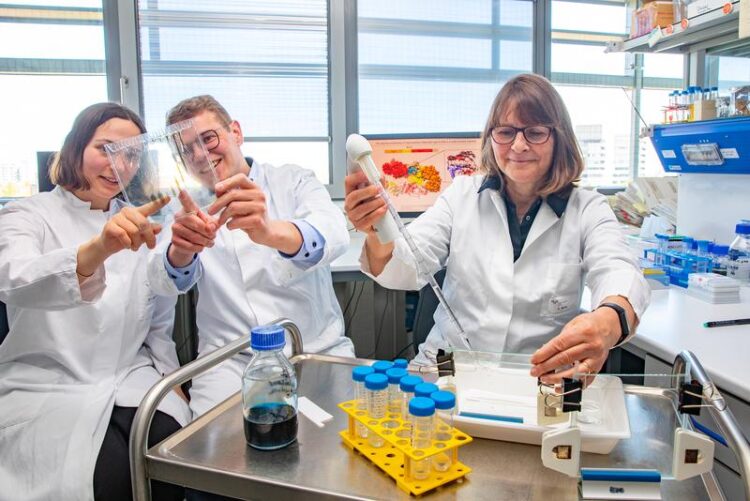Key to a cheaper and more accessible Hib vaccine found

Julia Schulze (left), Dr. Timm Fiebig and Andrea Bethe have deciphered the pathway of the bacterial capsule of Haemophilus influenzae type b (Hib).
Copyright: Karin Kaiser / MHH
The bacterium Haemophilus influenzae type b (Hib) can cause severe diseases such as meningitis and blood poisoning in young children. Researchers from the MHH Institute of Clinical Biochemistry have deciphered the pathway of the bacterial capsule and thus created the basis for producing the Hib vaccine inexpensive and safe.
The bacterium Haemophilus influenzae type b (Hib) inhabits the human nasal cavity. It causes infections of the upper and lower respiratory tract, especially in infants and young children. But even more serious diseases such as middle ear inflammation, meningitis or blood poisoning (sepsis) can be caused by Hib. The bacterium surrounds itself with a shell consisting of many sugar chains, which are also referred to as capsule polymers. With the capsule polymers, the bacterium protects itself against the host’s immune system and can thus survive in the human body. Vaccines against Hib are available, which contain the sugar polymers in the capsule and train the immune system to these antigens.
However, their production is complex and expensive. This is because the antigens must be obtained directly from infectious bacterial cultures, which requires a laboratory with an adequate level of safety. The team led by Dr. Timm Fiebig from the Institute of Clinical Biochemistry at the Hannover Medical School (MHH) has now succeeded in fully deciphering the path of formation of the capsule polymer for the first time and thus creating a possibility to produce the vaccine antigen cheaply and safely by enzymatic synthesis without the use of pathogens. The results have been published in the journal Nature Chemical Biology.
Simple synthesis could make vaccine more accessible worldwide
“The elucidation of the biosynthesis pathway enables a much more elegant production of Hib vaccine antigens from widely available and inexpensive precursors in a standard laboratory, without having to grow dangerous bacteria in bioreactors,” says Dr. Fiebig, head of the working group “Microbial Glycobiochemistry and Vaccine Development”. Despite the high effectiveness of the Hib vaccine introduced in Germany in the 1990s, the bacterium is still the main cause of bacterial meningitis in children under one year of age in unvaccinated societies. Thanks to the simplicity of the newly discovered synthetic pathway, the distribution of the vaccine could be improved worldwide.
Possible approach for new vaccines and drugs against bacteria
However, the research team has not only elucidated the production path itself, but also described the enzymes that control this process. “We have now for the first time comprehensively understood how the bacterium builds its polymer capsule and which enzymes it uses as tools for this,” says Dr. Fiebig. This enzyme factory can now be reproduced in the test tube under safe conditions. The most important enzyme is the so-called capsule polymerase, which produces the actual polysaccharide capsule and thus the antigen for the vaccine. The enzyme consists of four subunits. Three of them transfer chemical building blocks that occur in the surface polymers of many other bacteria and contribute to the pathogenic effect of the pathogens. However, it was not yet known which enzymes transmit these building blocks and what these enzymes look like three-dimensional. However, this is crucial for the development of antibacterial agents and for the discovery of new enzymes that control how bacteria cheat our immune system and how infectious they are.
The researchers were also able to identify the same polymerase structures in other bacteria. These include the intestinal bacterium Escherichia coli, the most antibiotic-resistant Acinetobacter species, or even the listeria found on contaminated foods. “Our findings could also be used to develop vaccines or drugs against these and other pathogens, for example by developing substances that block the newly discovered enzymes and thus interrupt the formation of the protective capsule,” says Dr. Fiebig. In view of the increasing resistance to antibiotics, this is a promising option in the fight against bacteria. However, further research is needed to achieve this.
SERVICE:
The original work “A multi-enzyme machine polymerizes the Haemophilus influenzae type b capsule” can be found here: https://www.nature.com/articles/s41589-023-01324-3
For further information, please contact Dr. Timm Fiebig, fiebig.timm@mh-hannover.de, phone (0511) 532-5212.
Media Contact
All latest news from the category: Health and Medicine
This subject area encompasses research and studies in the field of human medicine.
Among the wide-ranging list of topics covered here are anesthesiology, anatomy, surgery, human genetics, hygiene and environmental medicine, internal medicine, neurology, pharmacology, physiology, urology and dental medicine.
Newest articles
Faster, more energy-efficient way to manufacture an industrially important chemical
Zirconium combined with silicon nitride enhances the conversion of propane — present in natural gas — needed to create in-demand plastic, polypropylene. Polypropylene is a common type of plastic found…

Energy planning in Ghana as a role model for the world
Improving the resilience of energy systems in the Global South. What criteria should we use to better plan for resilient energy systems? How do socio-economic, technical and climate change related…

Artificial blood vessels could improve heart bypass outcomes
Artificial blood vessels could improve heart bypass outcomes. 3D-printed blood vessels, which closely mimic the properties of human veins, could transform the treatment of cardiovascular diseases. Strong, flexible, gel-like tubes…





















